- 09
- Dec
Inona no atao hoe Current?
Inona no atao hoe courant elektrika? Tsiahivina aloha, inona no famaritana ny courant nianaranay?
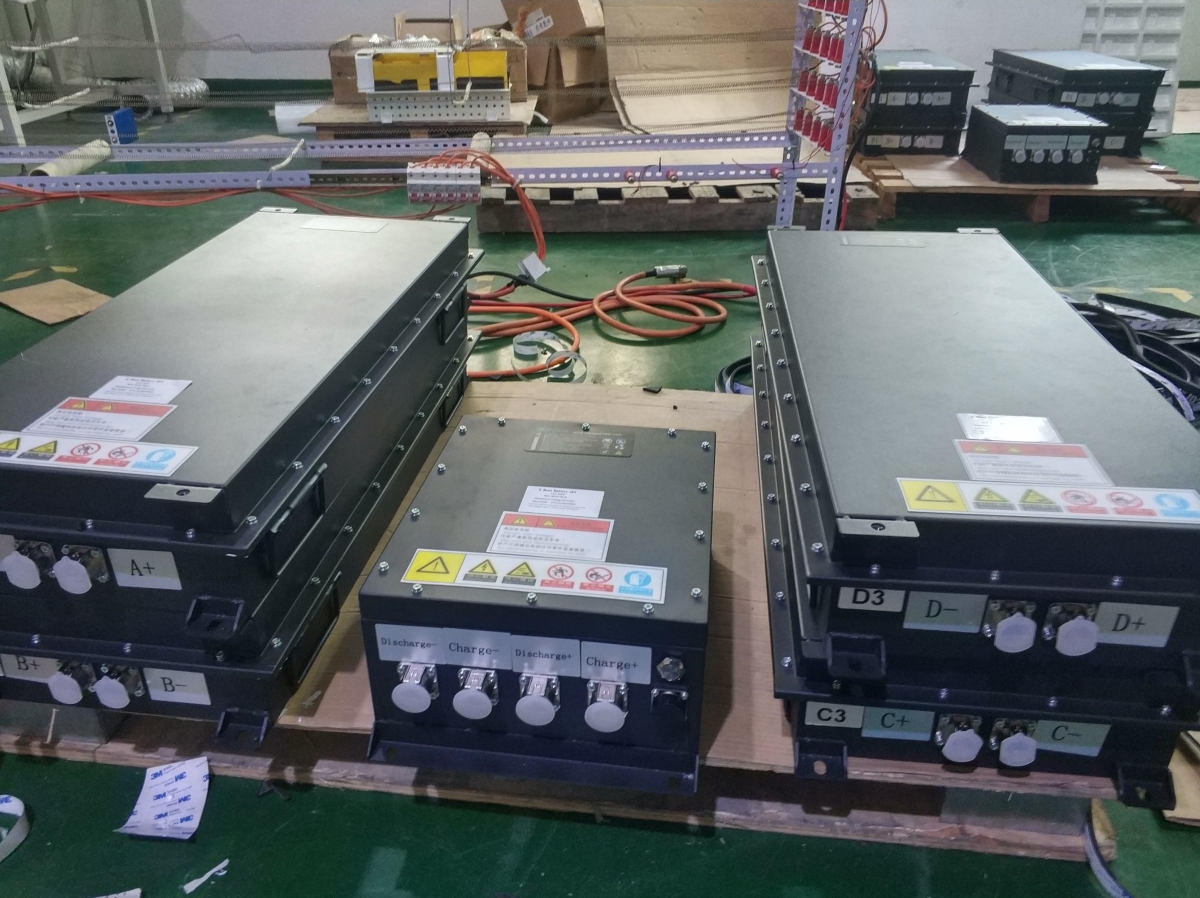
Tsotra fotsiny, ny fihetsehan’ny poti-javatra voampanga ao amin’ny conducteur dia koriana elektrika.
Rehefa misy poti-javatra afaka mihetsiketsika malalaka ny zavatra iray, dia afaka mamindra rivo-mahery, izany hoe mitondra herinaratra. Ireo singa voampanga izay mandray anjara amin’ny conduction dia antsoina hoe carrier. Ho an’ny metaly, ohatra, ny elektrôna ivelany amin’ny atôma ihany no afaka miasa ho mpitatitra.
Ny “hetsika tari-dalana” amin’ny famaritana ny herinaratra elektrika dia matetika tsy azo. Maro ny olona mihevitra fa milaza ny hetsika amin’ny lalana iray, mazava ho azy fa tsy izany! Tsy miova ve ny lalan’ny fihetsehan’ny elektrôna ao amin’ny circuit AC?
In fact, orienteering is relative to “random movement”!
Since electrons are microscopic particles, they must be in thermal motion all the time. Thermal motion is a random motion, as shown in the figure below. 
This movement is actually very fast. For example, in metals at room temperature, the speed of electronic thermal movement is on the order of hundreds of kilometers per second!
Raha jerena akaiky ity hetsika kisendrasendra ity dia ho hitanao fa kisendrasendra na oviana na oviana ny lalan’ny fivezivezen’ny singa tsirairay. Raha ampidirinao ny vectors velocity an’ireo singa ireo, dia saika aotra ny vokatra.
Ampio saha elektrika amin’ny conducteur izao, ary ny elektrôna dia mametraka hetsika ara-dalana mifototra amin’ny hetsika kisendrasendra. Raha heverina fa miankavia ny saha elektrika mandritra ny fe-potoana iray, dia toy izao manaraka izao ny fihetsiky ny elektronika. Ny baolina mena dia maneho atôma metaly eo amin’ny makarakara kristaly, ary ireo teboka mihetsika haingana dia maneho elektronika malalaka. 
Toa haingana ve izany? Izany dia satria ny hetsika elektronika dia tena haingana! Saingy raha ny marina, ny hetsika kisendrasendra, izay miantoka ny ampahany betsaka amin’izany, dia tsy mandray anjara amin’ny riandrano. Rehefa esorina ny hetsika kisendrasendra, ny ambiny dia mitovy amin’ny fijery miadana etsy ambany.
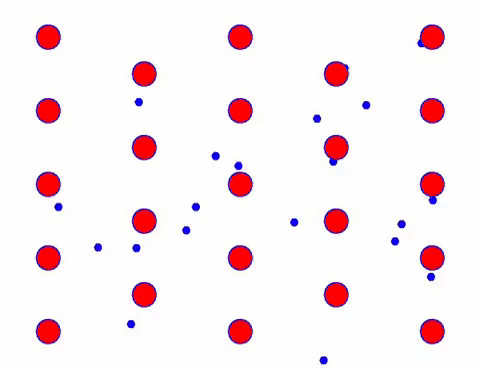
Indeed, the directional movement of electrons is much slower than the speed of thermal movement. This “grinding” movement of electrons is called drift, or “drift”. Sometimes, electrons will run in the opposite direction because of collisions with atoms. But in general, electrons move in one direction.
Raha miova lalana ny saha elektrika, dia hiova koa ny lalan’ny fifindran’ny elektronika.
Noho izany, ity karazana hetsika fitarihana ity dia midika fa ny fitambaran’ny hafainganam-pandehan’ny elektrôna rehetra mandray anjara amin’ny fampitana amin’ny fotoana iray dia tsy aotra, fa amin’ny ankapobeny dia amin’ny lalana iray. Ity lalana ity dia azo ovaina amin’ny fotoana rehetra, ary izany no trangan’ny courant alternating.
Noho izany, ny courant dia tsy hoe “hetsika mivantana” amin’ny fiampangana herinaratra fa ny “hetsika iombonana” amin’ny fiampangana herinaratra.
The magnitude of the current in the conductor is expressed by the current intensity. The current intensity is defined as the amount of electricity passing through the cross-section of the conductor in a unit time, namely
Nianatra habe ara-batana izahay izay misy ny teny hoe “intensité”, toy ny hamafin’ny saha elektrika sy ny hamafin’ny induction magnetika. Izy ireo amin’ny ankapobeny dia maneho ny fizarana isaky ny ora iray, ny velaran’ny tarika (na ny haben’ny tarika, ny zoro solida iray). Na izany aza, ny teny hoe “intensity” amin’izao fotoana izao dia tsy mampiseho ny fizarana amin’izao fotoana izao ny faritra.
Raha ny marina, ny habetsahana ara-batana hafa dia tompon’andraikitra amin’ny fizarana ny ankehitriny amin’ny faritra, izay ny hakitroky amin’izao fotoana izao.
Satria ny maha-zava-dehibe ny herinaratra elektrika dia ny fihetsehan’ny fiampangana herinaratra, tsy maintsy misy fifandraisana manokana eo amin’ny hamafin’ny ankehitriny sy ny hafainganam-pandeha!
Mba hahazoana io fifandraisana io, dia tsy maintsy manazava aloha ny fifantohan’ny mpitatitra hevitra, izany hoe ny isan’ny mpitatitra ao anatin’ny volume iray, izay asehon’ny .
It is assumed that the conductor cross section is, the carrier concentration is, the drift velocity is, and the charged charge is.
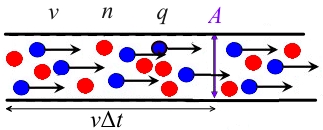
Avy eo ny fiampangana ao amin’ny conducteur eo amin’ny ilany havia amin’ny surface dia, ary ireo fiampangana ireo dia handalo amin’ny tany ao anatin’ny fe-potoana iray, ka
This is a microscopic expression of current intensity.
Ny hakitroky amin’izao fotoana izao dia ny fizarana ny ankehitriny amin’ny faritra, noho izany dia ny halehiben’ny hakitroky amin’izao fotoana izao, saingy voafaritra ho vector izy io, ary ny tari-dalana dia ny fitarihan’ny vector velocity drift an’ireo mpitatitra mitondra entana, ka ny fifindran’ny elektronika ao amin’ny metaly azo azo avy amin’ity Speed, toy ny ohatra etsy ambany.
Consider a copper wire, assuming that each copper atom contributes an electron as a carrier. There is 1 mol of copper, its volume is, molar mass is, density is, then the carrier concentration of the copper wire is
Aiza ny tsy tapaka an’i Avogadro. Ny hakitroky ny varahina dia hita, ary ny sanda azo amin’ny fanoloana dia eo amin’ny iray / metatra toratelo.
Raha heverina fa 0.8mm ny halalin’ny tariby varahina, ny mikoriana dia 15A, = 1.6 C, ary ny hafainganam-pandehan’ny elektronika dia kajy toy ny
Hita fa tena kely tokoa ny hafainganam-pandehan’ny elektrôna.
Ho an’ireo izay mianatra circuits, ny etsy ambony dia ny famaritana feno ny ankehitriny.
Fa amin’ny fizika, ny famaritana etsy ambony momba ny ankehitriny dia tena famaritana tery fotsiny. Tsy voafetra ho an’ny conducteur ny cours ankapobe kokoa, raha toa ka courant ny fivezivezen’ny fiampangana herinaratra. Ohatra, rehefa mivezivezy manodidina ny nucleus ny elektrôn’ny atoma hydrogène, dia misy courant elektrika miforona ao amin’ny orbitny.
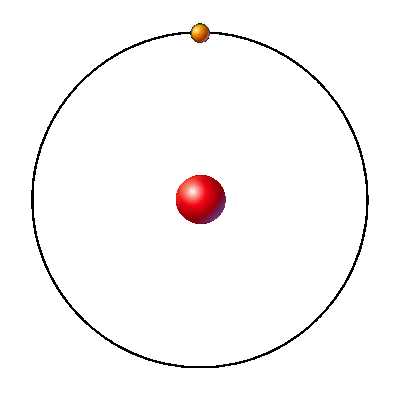
Eritrereto hoe ny habetsahan’ny fiampangana elektronika dia ary ny fe-potoana fihetsehana dia. Avy eo isaky ny mandeha izany dia misy fiampangana be dia be mandalo amin’ny fizarana hazo fijaliana amin’ny tadivavarana, noho izany ny hamafin’izao fotoana izao dia mifototra amin’ny fifandraisana misy eo amin’ny vanim-potoana, matetika ary ny hafainganam-pandehan’ny zoro, ary ny ankehitriny dia azo aseho ho toy ny
Ohatra iray hafa, ny kapila metaly misy fiampangana, mihodina manodidina ny axis, dia mamorona rivo-doza miaraka amin’ny taratra samihafa.

This kind of current is not a normal conduction current and cannot generate Joule heat! Can not form a real circuit.
Raha tsy izany, azonao atao ve ny manome ahy kajy hoe ohatrinona ny hafanana joule aterak’ireo elektrôn’ny atoma hidrôzenina?
In fact, the current in vacuum does not satisfy Ohm’s law. Because, for the electric current formed by the movement of charged particles in the vacuum, the carriers are not collided similar to the lattice in the metal, so the vacuum has no resistance and no conductance.
Ny fihetsehan’ny fiampangana elektrika dia miteraka herinaratra, ary ny fiampangana herinaratra mihitsy no mampientanentana ny saha elektrika. Mora miteraka tsy fifankahazoana izany. Maro àry no mihevitra fa tsy maintsy miharihary ny sahan’ny elektrônika amin’ireo poti-javatra voampanga izay mandrafitra ny herinaratra. Fa raha ny marina, ho an’ny conduction ankehitriny ao amin’ny conducteur ankapobeny, ny mpitatitra dia mikoriana amin’ny afara misy ion metaly be fiampangana tsara, ary ny conducteur mihitsy dia tsy miandany!
Matetika antsoina hoe “current equivalent” io karazana cours manokana io. Ny equivalent eto dia midika fa miteraka sahan’andriamby mitovy fototra amin’ny cour conduction mahazatra!
Reminder: Do not confuse the “equivalent current” here with the “equivalent circuit” in circuit analysis
Raha ny marina, tamin’ny voalohany nandinika ny sahan’andriamby isika, ny courant elektrika ao amin’ny lalàn’i Biot-Saffar dia ny courant elektrika ankapobeny izay misy io courant mitovy io. Mazava ho azy fa ny conduction current ao amin’ny equations Maxwell dia manondro ihany koa ny current generalisé.
Those who have studied the photoelectric effect know that when the photoelectron drifts from the cathode to the anode, if the influence of air is ignored, this current is caused by the movement of electric charges in the vacuum, and there is no resistance, so it is not restricted by Ohm’s law.
So, is this the only thing about electric current in physics?
No! There are also two types, namely magnetizing current and displacement current.
Izy ireo koa dia riandrano roa mitovy, izay, araka ny hevitr’ilay anarana, dia nampidirina ihany koa mba hanazavana ny magnetisma. Raha lazaina amin’ny teny hafa dia niala tamin’ny toetra fototry ny “hetsika fiampangana” ankehitriny izy ireo!
That’s amazing! There is no electric charge movement, so why can it be called an electric current?
Don’t worry, and listen to me slowly.
Andeha hojerentsika aloha ny koin’ny magnetizing.
Hita fa vokatry ny fihetsehan’ny herinaratra ny andriamby (tsy jerena ny fanazavana momba ny andriamby amin’ny toetran’ny spins amin’izao fotoana izao). Mba hanazavana ny andriamby voajanahary, dia nametraka ny petra-kevitra momba ny “circulation molekule” ilay mpahay fizika frantsay Ampere. 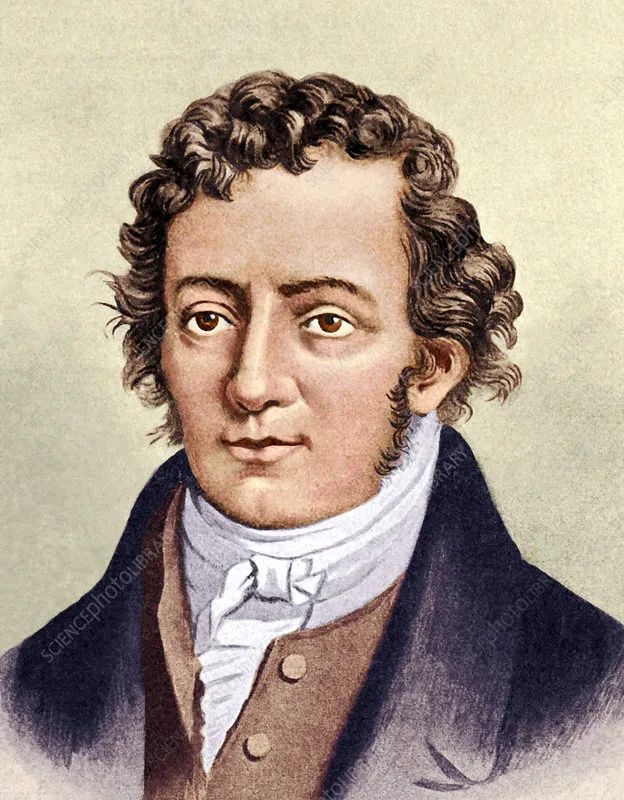
Araka ny asehon’ny sary etsy ambany, ny atôma na molekiola rehetra dia azo heverina ho misy fiampangana herinaratra mihodina manodidina ny afovoany, ka mamorona korian-tsolika kely, izany hoe “mihodina molekiola”.
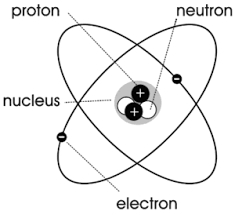
Araka ny lalàna fa ny herin’aratra dia mampientanentana ny sahan’andriamby, ity fihodinana molekiola ity dia hamokatra habe ara-batana antsoina hoe fotoana magnetika. Ny habeny dia ny faritra voahodidin’ny fihodinan’ny molekiola ampitomboina amin’ny cours mitovy amin’ny fihodinan’ny molekiola, ary ny fitarihany dia amin’ny fifandraisana miolikolika amin’ny tanana havanana amin’ny lalan’ny fihodinana, izany hoe
Mazava ho azy fa ny lalan’ny fotoana andriamby dia mifanaraka tsara amin’ny lalan’ny sahan’andriamby noforonin’ny kojakoja mivezivezy.
. 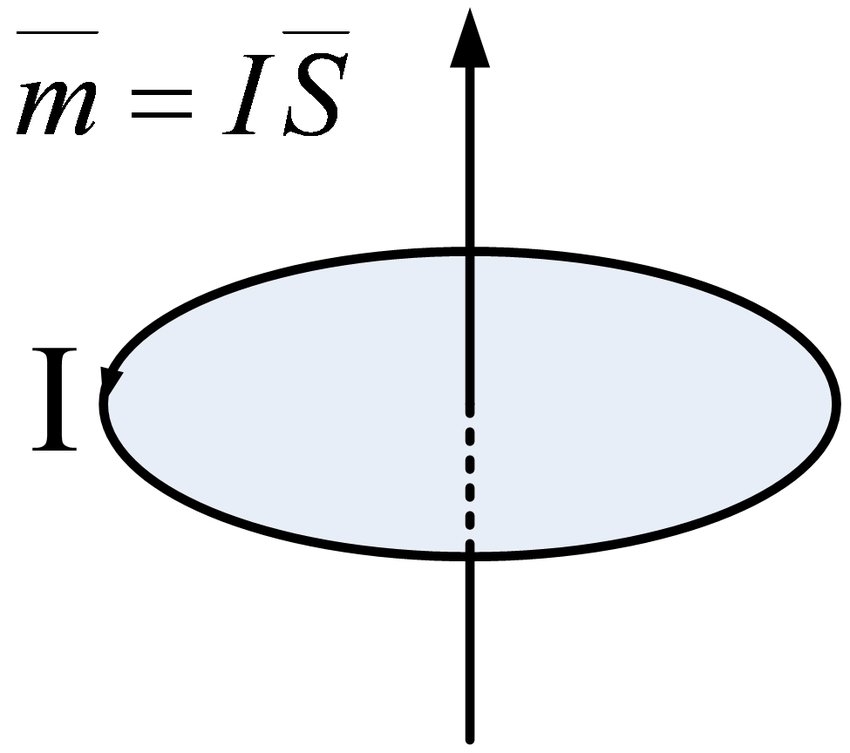
Under normal circumstances, the arrangement of the molecular circulation of a substance is chaotic, so the substance is not magnetic, as shown on the left side of the figure below. When subjected to an external magnetic field, these molecular circulations will be approximately neatly arranged. As shown on the right side of the figure below, their magnetic moments are arranged in one direction as much as possible, just like countless small magnetic needles gathered together to form a total magnetic field, and the whole material composed of them becomes magnetic.
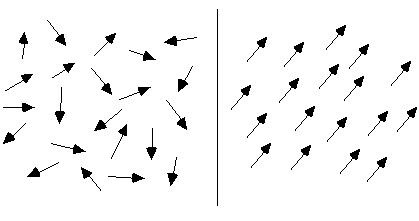
Suppose there is a cylindrical magnet, the inner molecular circulation is neatly arranged, and the sections of each molecular circulation at the edge of the magnet section are connected together to form a large circulation, as shown in the figure below. 
Mifototra amin’izany, azontsika atao ny mieritreritra fa ny andriamby bar dia toy ny solenoid mahery. Raha lazaina amin’ny teny hafa dia misy courant tsy hita maso mifatotra eo ambonin’ny andriamby! Tsy azo ampifandraisina sy ampiasaina io karazana courant io. Izy io dia voafetra amin’ny endriky ny andriamby. Antsoinay hoe “current binding” na “current magnétique”.
Noho izany, ny courant magnetizing dia courant, satria mitovy amin’ny ankehitriny noforonin’ny ny hetsika ny tena herinaratra fiampangana, izay afaka mitovy mitovy sahan’andriamby!
Andeha hojerentsika indray ny courant de displacement.
According to the Ampere’s loop theorem, the integral of the magnetic field strength on a closed path is equal to the flux of the current density on any curved surface bounded by this path, that is, this theorem is called Stokes’ theorem in mathematics. It tells us that the integral of a vector along any closed path must be equal to the flux of its curl (here) to any surface bounded by the closed path.
Koa satria teôrema matematika izy io, dia tsy maintsy ho marina foana, satria rafitra lojika mifototra amin’ny axioms ny matematika.
Therefore, the Ampere Loop Theorem must always hold!
However, the talented Scottish physicist Maxwell discovered that when faced with an unstable current circuit, the Ampere loop theorem was contradictory.
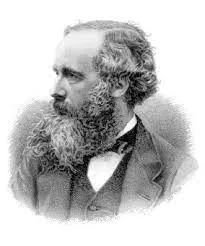
Ny ankehitriny tsy marin-toerana mahazatra dia mitranga mandritra ny fiampangana sy famoahana ny capacitor. Araka ny aseho eo amin’ny sary etsy ambany, dia misy ankehitriny tsy marin-toerana mandritra ny fotoana fohy ny capacitor mamaly.
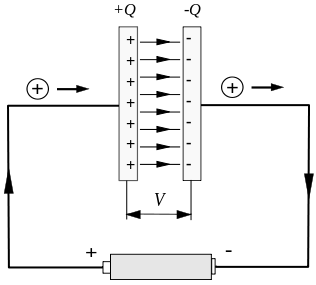
Fa ny faritra dia tapaka eo amin’ny capacitor takelaka, izay hiteraka olana lehibe.
Aoka hatao hoe mandinika lalana mihidy izay mandalo ny tariby, araka ny aseho eo amin’ny sary etsy ambany, ny faribolana voamariky ny C, ary ny curved ambonin’ny miaraka amin’ny toy ny sisin-tany azo arbitrarily voafantina. Ao amin’ny sary dia voafantina ny fiaramanidina boribory voafehin’ny C sy manerana ny capacitor. Ny velarana miolakolaka amin’ny takelaka havia. 
Araka ny boribory ambonin’ny, dia hita fa araka ny curved ambonin’ny, fa toy ny tadivavarana integral ny herin’ny sahan’andriamby, dia tokony ho tapa-kevitra ny sandany!
Ahoana no atao?
Maxwell believes that the Ampere’s loop theorem must be established. Now that there is a problem, it must be because a part of the current has not been discovered by us before, but it does exist!
Noho izany, ahoana no ahafantarana ity ampahany amin’ny ankehitriny ity?
Satria eo anelanelan’ny takelaka ny olana, manomboka eo anelanelan’ny takelaka.
Tamin’ny alalan’ny famakafakana, Maxwell dia nahita fa na inona na inona fiampangana na famotsorana, dia misy habetsahana ara-batana eo amin’ireo takelaka capacitor amin’ny fotoana rehetra izay mifanaraka amin’ny habeny sy ny fitarihan’ny ankehitriny. Izany dia ny fotoana derivative ny flux ny elektrika displacement vector, izany hoe, dia faritana ho ny fifindran ny ankehitriny.
Raha heverina fa io ampahany io no ampahany amin’ny courant izay tsy mbola hita teo aloha, dia izao ny courant feno. Izany hoe, na dia tapaka aza ny fizaran-tany eo amin’ny takelaka, ny derivative amin’ny fifindran’ny herinaratra elektrika sy ny fitambaran’ny ankehitriny miaraka, amin’ny ankapobeny , Miantoka ny fitohizan’ny courant amin’ny fotoana rehetra.
Raha miverina amin’ny fifanoherana teo aloha, dia fantatsika izao fa, araka ny fepetra takian’ny Stokes’ theorem, rehefa mikajy ny flux ny hakitroky amin’izao fotoana izao ho an’ny faritra mihidy, dia tokony hodinihina koa ny hakitroky ny fifindran’ny ankehitriny, izany hoe ny ampere loop feno. Ny theorem dia noho izany, Amin’ny alalan’ny “fahitana” ity singa vaovao ankehitriny ity, dia voavaha ny krizy amin’ny Theorem Loop Ampere!
The reason why “introduction” is not used here, but “discovery” is used here. What I want to emphasize is that this kind of current is not a mathematical compensation, but a real thing, but it has not been discovered before.
Why does it exist in the first place? Because it acts as an electric current, like a conduction current, it excites a magnetic field equivalently, except that there is no movement of electric charges, no wire is required, and no Joule heat can be generated, so it has been ignored!
Fa tena misy ho azy io, tazomy kely fotsiny, dia nampientanentana mangina ny sahan’andriamby tao foana!
In other words, when we face a magnetic field, the original definition of current is too narrow. The essence of electric current is not the movement of electric charge, it should be something that can excite a magnetic field.
Hatramin’izao dia efa nampidirina ireo endrika maro samihafa. Izy rehetra dia misy amin’ny fomba tsy mitongilana, ary ny iraisan’izy ireo dia ny hoe ny riandrano rehetra dia afaka mampientanentana ny sahan’andriamby.
